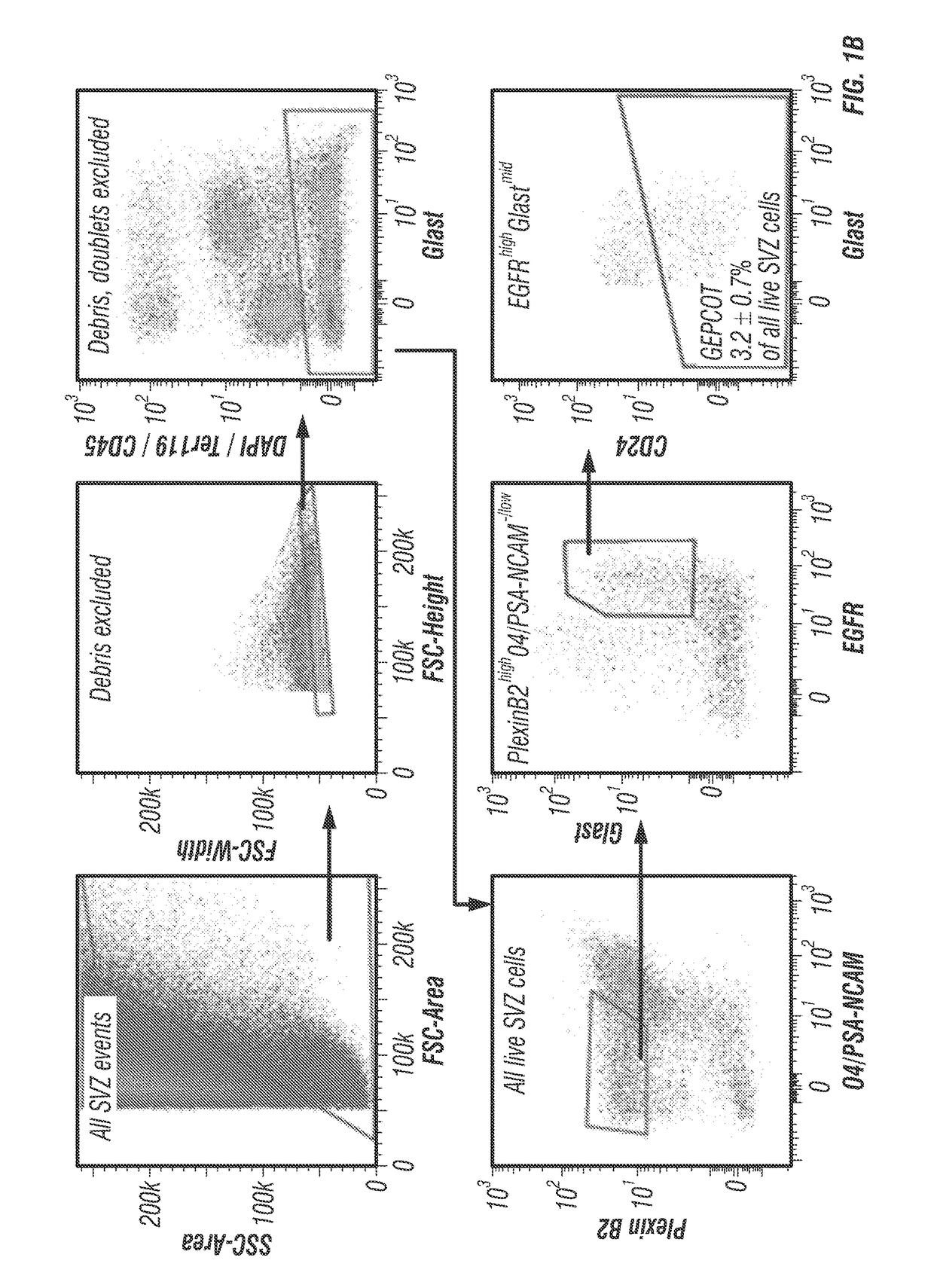Identification and isolation of neural stem cells and neurosphere initiating cells
a neural stem cell and initiating cell technology, applied in the field of neurology and developmental biology, can solve the problems of hampered efforts to assess their properties, inability to directly study qnscs or nics as they exist in vivo, and uncertainty regarding the relationship between qnscs and nics
- Summary
- Abstract
- Description
- Claims
- Application Information
AI Technical Summary
Benefits of technology
Problems solved by technology
Method used
Image
Examples
example 1
Materials and Methods
[0095]Mice. C57B1 / 6 mice were maintained in standard cages with water and standard diet (Teklad 2916) ad libitum. Rosa26CAG-loxp-Stop-loxp-tdTomato(Ai14) (referred to here as loxp-tdTomato) (Madisen et al., 2010), Gli1CreERT2 (Ahn and Joyner, 2005), Sox2CreERT2 (Arnold et al., 2011), Dlx1CreERT2 (Taniguchi et al., 2011), Tg(Glast-CreERT) (Wang et al., 2012), Tg(Nestin-Cre) (Tronche et al., 1999) and Tg(Ubc-GFP) (Schaefer et al., 2001) mice were obtained from The Jackson Laboratory. Tg(GFAP-CreERT2) (Hirrlinger et al., 2006) mice were provided by Frank Kirchhoff. Tg(Nestin-GFP) (Birbrair et al., 2011) and Tg(Nestin-mCherry) (Ding et al., 2012) mice were kindly provided by Grigori Enikopalov. Tg(Nestin-CreERT2) mice were provided by G. Fishell (Balordi and Fishell, 2007). All mice were backcrossed onto a C57BL / Ka background for at least 3 generations prior to analysis. For BrdU pulses up to 24 hours, 100 mg of BrdU / kg body mass dissolved in PBS was injected i.p. e...
example 2
Results
[0106]Prospective identification of NICs. The inventors enzymatically dissociated adult mouse SVZ cells then sorted cells by flow cytometry into non-adherent cultures at clonal density (0.66 cells / μl of culture medium). The inventors always replated neurospheres to adherent secondary cultures to assess differentiation into TuJ1+ neurons, GFAP+ astrocytes, and O4+ oligodendrocytes. On average, 1.8±0.4% of SVZ cells formed neurospheres (>50 μm diameter) and 75% of those neurospheres underwent multilineage differentiation (1.4±0.3% of SVZ cells).
[0107]The inventors systematically screened 383 antibodies against 330 distinct cell surface antigens (data not shown) to identify markers that could enrich NICs (FIG. 1A). The inventors identified 49 markers by flow cytometry that were heterogeneously expressed among dissociated SVZ cells. For each of these markers they sorted SVZ cells that differed in their level of staining into non-adherent cultures and assessed neurosphere formatio...
example 3
Discussion
[0142]By screening almost four hundred antibodies against distinct cell surface antigens, the inventors identified two phenotypically and functionally distinct populations of neural stem / progenitor cells from the adult mouse SVZ. GEPCOT cells were highly enriched for NICs (FIG. 1C) and highly mitotically active in vivo (FIG. 1D) but persisted only transiently in the SVZ based on fate mapping with Ascl1CreERT2 or Dlx1CreErT2 (FIGS. 2B-C). In contrast, pre-GEPCOT cells lacked the ability to form neurospheres or adherent colonies in culture (FIG. 4B), and were quiescent in vivo (FIG. 4C) but were long-lived in the SVZ based on fate mapping with the stem cell markers Glast-CreERT (Wang et al., 2012), GFAP-CreERT2 (Giachino et al., 2013), Sox2CreERT2 (Arnold et al., 2011), and Gli1CreERT2 (Ahn and Joyner, 2005; Lee et al., 2012) (FIGS. 4F-J). In contrast to GEPCOT NICs, pre-GEPCOT cells were resistant to TMZ (FIGS. 5E-F). Although TMZ eliminated virtually all NICs from the SVZ ...
PUM
| Property | Measurement | Unit |
|---|---|---|
| depth | aaaaa | aaaaa |
| frequency | aaaaa | aaaaa |
| body mass | aaaaa | aaaaa |
Abstract
Description
Claims
Application Information
 Login to View More
Login to View More - R&D
- Intellectual Property
- Life Sciences
- Materials
- Tech Scout
- Unparalleled Data Quality
- Higher Quality Content
- 60% Fewer Hallucinations
Browse by: Latest US Patents, China's latest patents, Technical Efficacy Thesaurus, Application Domain, Technology Topic, Popular Technical Reports.
© 2025 PatSnap. All rights reserved.Legal|Privacy policy|Modern Slavery Act Transparency Statement|Sitemap|About US| Contact US: help@patsnap.com



